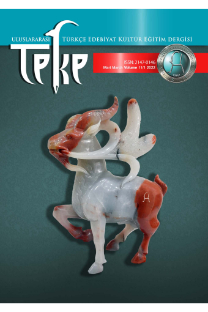OKUL ÖNCESİ ÇOCUKLARININ PİYANO EĞİTİM METOTLARI ÜZERİNE BİR GÖZLEM VE DEĞERLENDİRME
Piyano eğitimi, müzik eğitimi içerisinde oldukça ilgi gören çalgı eğitimlerinden biri olarak düşünülmektedir. Çocuklar, gençler ve hatta orta yaş ve üzerindekiler bile piyano eğitimi almak istemektedirler. Bunun nedenleri ayrı bir araştırma konusu olması ile birlikte, piyano eğitiminde sabırlı, programlı ve disiplinli bir eğitim sürecine ihtiyaç olduğu bilinmektedir. Piyano eğitiminde özellikle okul öncesi yaşlarda bulunan küçük çocukların karşısına, diğer çocuk çalgılarında görülmeyen tuş sisteminin gelmesi ile çocukları karışık ve sayıca fazla olan piyano tuşlarına yakınlaştırmak, piyano eğitimi yöntemlerini araştırmış bilgili bir eğitmen için sorun olmayabilmektedir. Bu eğitim sürecinde öncelikle dikkat edilmesi gereken husus, oyun oynayarak ve taklit ederek seslerin eğitim sürecine alınmasını sağlamaktır. Bunun amacı, işitilen seslerin düzgün ve yerinde çalınmasının hedeflenmesidir. Seslerin tiz-pes veya uzun-kısa olarak algılanmasını amaçlamak önemlidir. Böylece çocuğun beyni yani düşünce sistemi ile psikomotor yapabilirlikleri arasında bir bağ kurulmasını gerçekleştirmek mümkün olacaktır. Piyano eğitiminde karşılaşılan en önemli problemlerden birinin eğitici ve öğretici kaynak eser sorunu olduğu düşünülmektedir. Bu çağ çocuklarına uygulanacak metotlara, çok yaygın olmamakla birlikte, son yıllardaki iletişim ve teknolojik gelişmeler doğrultusunda ulaşmak daha mümkün hale gelmiştir. Bu çalışmada okul öncesi çocukların piyano eğitimi ile ilgili bazı metotlar üzerine bir araştırma yapılacak ve mevcut metot çalışmaları değerlendirilecektir.
AN OBSERVATION AND EVALUATION OF PIANO EDUCATION METHODS FOR PRE-SHOOL CHILDREN
Piano education is considered to be one of the most interesting instrumental trainings in music education. Children, young people and even middle-aged and older people want to study piano. With the reasons for this being a separate research topic, it is known that a patient, programmed and disciplined training process is needed in piano education. Piano education in particular against young children in pre-school age, with the arrival of the keyboard system - which is not seen in other children's keyboard - to reach the piano keys are mixed and large numbers of children, piano education methods and investigations, and a knowledgeable instructor may not be a problem. In piano education, making pre-school children who are experiencing a complex keyboard system with many keys, which is not seen in other child instruments, feel comfortable in the learning process might not be a big issue for a knowledgeable educator who has studied piano education methods. In this training process, it is important to pay attention to the fact that the voices are taken into the education process by playing game and imitating sounds. The aim is to target playing the sounds heard with exact sounds at exact sequence. It is important to aim identifying sounds as treble-bass or long-short in the education. In this way, making a connection between child’s brain or child’s thinking system and psychomotor abilities will be possible. One of the most crucial problems encountered in piano education is believed to be the short of teaching and training resources. Despite the fact that the methods to be applied to children of this age are not very common, nowadays proper resources have become available by means of communication and technological advancements. In this study, some methods related to piano education of preschool children will be researched and current studies on methods will be evaluated.
___
- WOLTERS, K. (1985). Handbuch der Klavierliteratur, zu Zwelhanden. Atlantis Musickbuch Verlag.
- WOLTERS, K. (1975). Orientierungs Modell Klavier Unterstufe. Regensburg: Gustav Bosse Verlag.
- USZLER, M., GORDON, S., & SMITH, S. (2000). The Well-Tempered Keyboard Teacher (2nd ed.). New York: Schirmer Books, 35.
- ŞENDURUR, Y. ve BARIŞ, D. (2002). Müzik eğitimi ve çocuklarda bilişsel başarı. Gazi Eğitim Fakültesi Dergisi, 22(1), 165-174.
- SCHAUM, W. J. (1965). Wir Musizieren am KLavier. Köln: Bosworth Edition.
- PAMİR, L. (1986). Çağdaş Piyano Eğitimi. İstanbul: Beyaz Köşk Yayınları No: 2, Türkiye Turing ve Otomobil Kurumu. Met-er Matbaası.
- ÖMEROĞLU, E., ERSOY, Ö. vd. (2003). Müziğin Okulöncesi Eğitimde Kullanılması. 1. Baskı, Ankara: Kök Yayıncılık, Aydoğdu Ofset, 17-18.
- OTACIOĞLU, S. (2002). İlköğretimde Ses Eğitimi. Yayınlanmamış Yüksek Lisans Tezi, İstanbul: Mimar Sinan Üniversitesi Sosyal Bilimler Enstitüsü.
- MANTIE, R., & TUCKER, L. (2008). closing The Gap: Does Musicmaking Have to Stop Upon Graduation? International Journal of Community Music, 1, 217–227.
- KREUTZ, G. (2008). Wie Kinder Musik Empfinden, Erleben und Lieben Lernen. Das OnlineFamilienhandbuch des Staatsinstituts für Frühpädagogik (IFP), 1-5.
- KILIÇ, I. (2011). Okul Öncesi Müzik Eğitimi. Ankara: Pegem Akademi.
- JUSLIN, P. N. (1997). Emotional Communication in Music Performance: A Functionalist Perspective and Some Data. Music Perception. 14 (4), 383-418.
- HALVAŞİ, B. (1989). Okul öncesi çocuklarda piyano eğitimi. Yayınlanmamış Yüksek Lisans Tezi, İstanbul: M.Ü. Fen Bilimleri Enstitüsü.
- GÜVEN, ÇEVİK vd. (2012). Çocuklara Yönelik Piyano Eğitimi Başlangıç Metotları Zerine Bir Değerlendirme. Eğitim ve Öğretim Araştırmaları Dergisi Journal of Research in Education and Teaching, 1(2).
- DYKME, W. P. ve CUNCLIFF, M. H. (1955). School Music Handbook. Boston: C. Birchard and Company.
- ÇALIŞIR, F. (1969). Çalgı Bilgisi. Ankara: İş Matbaacılık ve Ticaret.
- BURNAM, E. M. (1958). Step By Step. Book One, Ohio: Willis Music Company, Cincinati.
- ISSN: 2147-0146
- Yayın Aralığı: Yılda 4 Sayı
- Başlangıç: 2012
- Yayıncı: Cengiz Alyılmaz
Sayıdaki Diğer Makaleler
İSMAİL HAKAN AKGÜN, Fatma BULUT ÖZKAR
MUHİBBÎ DÎVÂNI’NDA EĞLENCE MECLĠSLERĠ VE ÇEġĠTLĠ UNSURLARI
REHBER ÖĞRETMENLİĞİN MURPHY YASALARI
TÜRKİYE TÜRKÇESİ AĞIZLARINDA SESLENME SÖZLERİ
YUSUF ATILGAN’IN ROMANLARINDA KAHRAMAN TİPOLOJİSİ
PROF. DR. AZMİ BİLGİN’İN ENÎSÜ’L-CELÎS ADLI ESER ÜZERİNE
OKUL ÖNCESĠ ÇOCUKLARININ PĠYANO EĞĠTĠM METOTLARI ÜZERĠNE BĠR GÖZLEM VE DEĞERLENDĠRME
DİL FELSEFESİ VE TÜRKÇE ÖĞRETİMİ
İrem BAYRAKTAR, Olcay BAYRAKTAR, Erhan DURUKAN
TÜRK DİLİNDE DAHA ÇOK ÇABA İSTEYEN DEĞİŞİMLER
ÖZEL AMAÇLI TÜRKÇE ÖĞRETİMİ DERS KİTABI ÖNERİSİ: BANKACILIK TÜRKÇESİ
